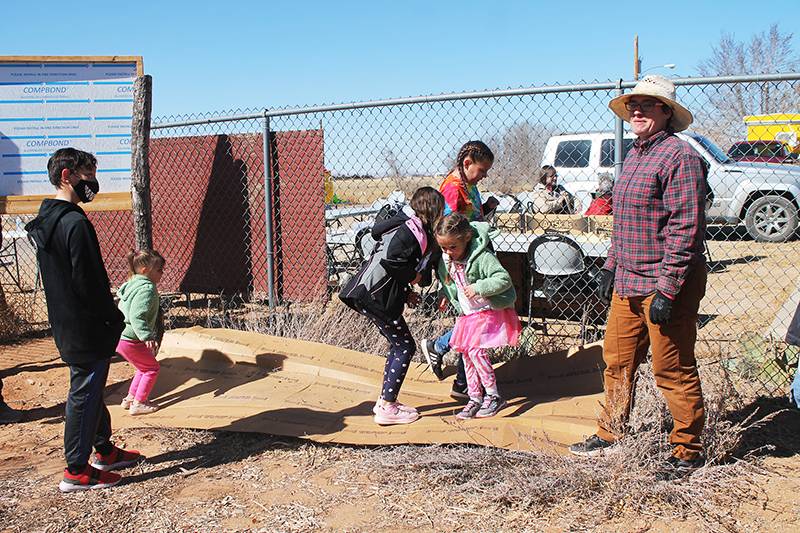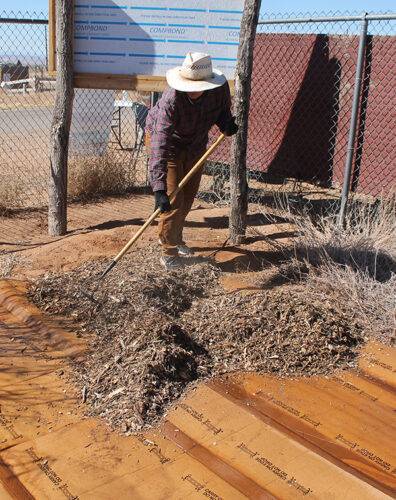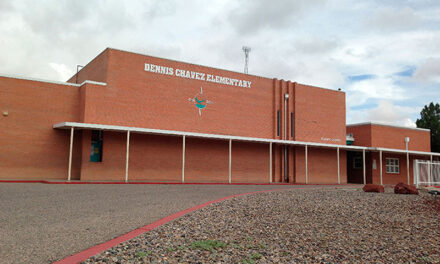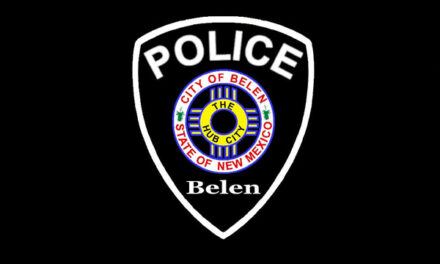More than 75 people from Valencia County and the surrounding area turned out last weekend to get their hands dirty, improve the east side community gardens and learn about the magic of mulching.
The nearly day-long event started at the community garden at El Cerro Community Center, where the group knocked out a sheet mulching project that will smother unwanted weeds and improve the soil as the components break down. They then traveled to the garden at the Meadow Lake Community Center for lunch and more mulching.
The mulching workshops, led by Amelia Vogel, farm manager and co-owner of Rocket Punch Farm, were part of a series of healthy soil events organized and hosted by the Valencia Soil and Water Conservation District.
“The primary purpose of these events is to spread information and build connections in the community,” said Andrew Hautzinger, VSWCD district director.
The technique of sheet mulching is fairly straight forward, Vogel said. Start by putting down a single layer of cardboard, free of metal staples and plastic tape, making sure the edges overlap.
“Bigger pieces make it easier but any size will work,” Vogel said.
She advised that if the cardboard had a shiny, printed layer, it should be peeled off as much as possible to make sure the cardboard breaks down.
If you have the ability to wet the cardboard down you can, she said, but it’s not necessary. After that, spread a 4-inch layer of mulch over the cardboard and dampen it again if wanted. The mulch can be just about any weed-free organic material, such as wood chips, spoiled hay, pine needles or autumn leaves.
“Some people try to make this really complicated but it doesn’t have to be. If you are looking to smother weeds, the cardboard and mulch is plenty. If you want to enrich the soil more, you can add a layer of compost between them,” Vogel said. “Look around and see what you have. Old leaves? Does your neighbor have some old manure? Almost any organic matter will work.”

Julia M. Dendinger | News-Bulletin photos
Sheet mulching is a quick and easy way to smother weeds. Amelia Vogel, farm manager and co-owner of Rocket Punch Farm, who led the Magical Mulching workshops last Saturday explains the layer of cardboard can be used to flatten out unwanted vegetation while a group of enthusiastic helpers demonstrates.
As the cardboard breaks down it will smother whatever plants are beneath it, even everyone’s least-favorite garden and yard pest, the goathead.
Vogel said she’s found large pieces of cardboard at local businesses, always asking first if she can take the waste. During the workshop at the El Cerro Mission garden, Vogel said a man with Old Mill Farm and Ranch Supply said cardboard was available at the Los Chavez location, 19763 N.M. 314.
Hautzinger said a local tree company regularly brings loads of wood chips to the Whitfield Wildlife Conservation Area, 2424 N.M. 47, owned and operated by the district, which is available to the public for free.
Vogel said if you can’t find cardboard, newspapers or unlined paper feed sacks can be substituted. She also advised against using weed barrier material.
“It doesn’t break down and usually ends up with dirt on top, then weed seeds and you’re back where you started,” she said. “If you are wanting to improve the soil for planting it can take about a year, sometimes less, depending on conditions. We bought our property and did sheet mulching in December and we planted in April.”

After a layer of cardboard is in place and wet down, Amelia Vogel spreads the wood chip mulch. The layer of mulch — which can be almost any weed-free organic material such as wood chips, spoiled hay, pine needles or fall leaves — needs to be about 4-inches thick.
Mulching of all kinds has numerous benefits, Vogel said, including retaining moisture, cooling the ground and reducing weeds. It also enriches the soil as it decomposes and rebuilds top soil and prevents erosion and runoff.
“Sheet mulching helps use things that would otherwise be thrown out, like cardboard,” she said. “You don’t have to remove existing plants in an area you want to do sheet mulching on. Just mow it and leave things there. That’s just more organic matter to break down.”
Meadow Lake garden manager Nohelia Cervantes was one of the community members who came to the workshops, making sure the area she wanted reserved for spring flowers didn’t get covered.
Involved with the garden since its inception six years ago, and manager for four years, Cervantes always had a love of plants, flowers and growing vegetables.
The community garden has been a benefit to the community since it has helped people have access to fresh produce.
“We have been able to give people organic vegetables,” Cervantes said. “But we need more volunteers. The garden doesn’t benefit people if they don’t come help.”
As the garden began to produce vegetables, garden interns like Cervantes’ daughter, Olga, 16, sold the produce for what buyers were able to pay. The small profits were reinvested in the garden.
When COVID-19 hit, Cervantes said she and the interns began giving away the vegetables, going to the local churches and the community center next to the garden.
“We just made everything free to everybody and everyone,” she said.
For more information about VSWCD programs, workshops and educational opportunities, visit valenciaswcd.org.
Click here for a video showcasing the two community gardens, the benefits they bring to their communities and a look at putting down the sheet mulching.
Julia M. Dendinger began working at the VCNB in 2006. She covers Valencia County government, Belen Consolidated Schools and the village of Bosque Farms. She is a member of the Society of Professional Journalists Rio Grande chapter’s board of directors.

















